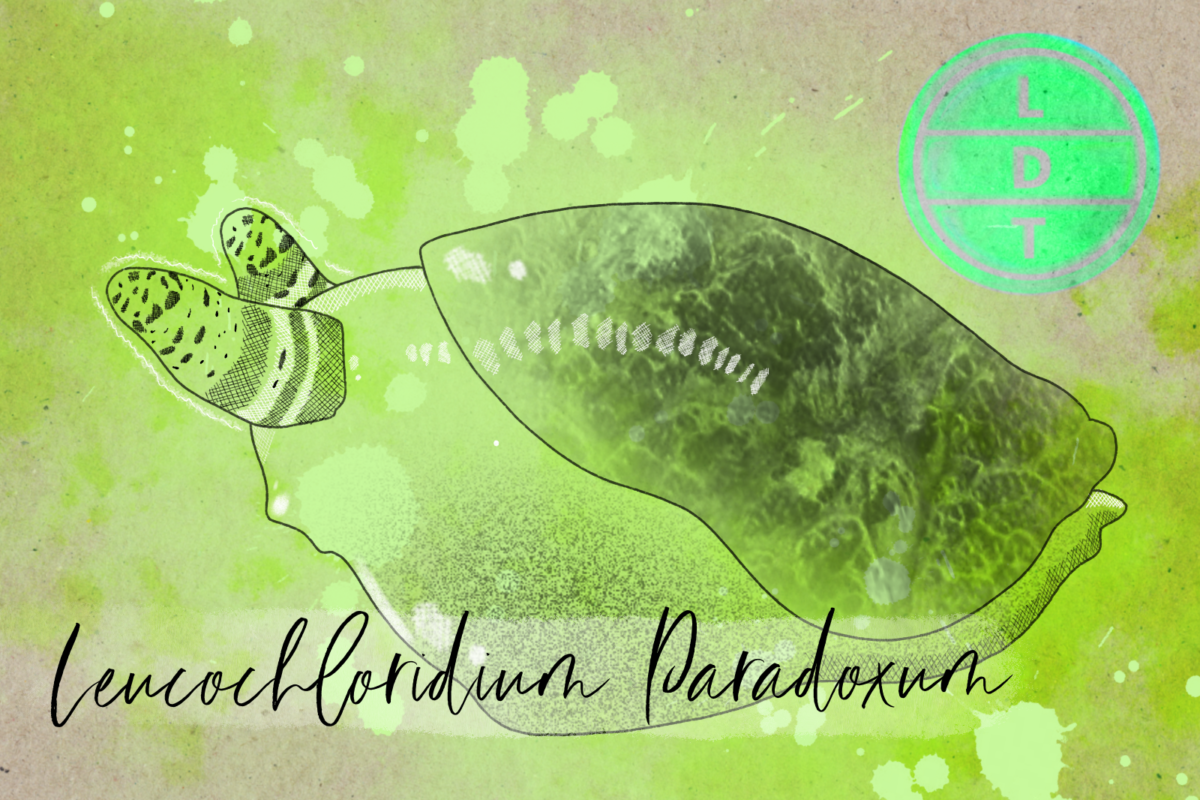“…and today we’re talking about parasitic creatures that Andrew Ryan would absolutely hate. But more on that later.”
Nature is sometimes beautiful and majestic, and sometimes it’s the most horrifying thing you’ve ever seen—but at least it’s almost always interesting! If you see a snail with large flashing horns on its head, you’re not looking at the world’s slowest Viking rave, you’re looking at the alluring dance of a superparasite. But, in the shrunken world of the green-banded broodsac, its eat and be eaten—before being eaten again here in Life, Death, and Taxonomy.
Description of the Green-Banded Broodsac
- The green-banded broodsac is a flatworm. It’s very small, especially during some points of its lifecycle.
- Individual adults are small oval shaped, amoeba things.
- But the green-banded broodsac phase we know and love, is more like a caterpillar shape with striking white and green stripes.
- The front of it is an offensive reddish brown spot.
- The back of it has a tail-like flagellum that attaches to a cluster of horror called sporocysts.
- New green-banded broodsacs grow from the sporocysts.
Measure up
Welcome to the beloved Measure Up segment. The official listener’s favorite part of the show! The part of the show when we present the animal’s size and dimension in relatable terms through a quiz that’s fun for the whole family. It’s also the part of the show that’s introduced by you when you send in audio of yourself saying, singing, or chittering the words Measure Up into ldtaxonomy at gmail dot com. We don’t have a new Measure Up intro, but we’re going to revisit our greatest hits.
Length
- Adult worms are 1.5 mm long.
- How many adult broodsac go into the length of the longest earthworm?
- Hint: The earthworm was found in South Africa in 1967. It was the species Microchaetus rappi. It’s about the diameter of a rubber hose.
- 4,267.2 worms. The worm was 6.7 m (21 ft) long.
Brood size
- 100–250 such metacercariae
- How many brood sacs go into the amount of people in the largest ever sack race?
- Hint: The race was held in Zwolle in the Netherlands, and was made up mostly of students from Agnieton College. The record was set in October 2002.
- 8.3 broods. The sack race had 2,095 people in it.
Fast Facts About the Green-Banded Broodsac
The broodsac is found throughout Europe, particularly in Germany, Poland, Belarus, Russian, Sweden, and Norway. They can be found as far flung as the UK and Japan. They may have found the species on a pacific Island called Robinson Crusoe Island.
It prefers moist areas, as is the case with most disgusting things. They particularly like marshlands.
The broodsac is a parasite, but more on that later. It has a complex life cycle, but that’s not uncommon for parasitic worms. Its life cycle is actually less complex than trematodes, which is another order of platyhelminthes.
Major Fact: Gone in a Flash
If we’ve said it once, we’ve said it a thousand times: the insect-sized world is a brutal one (snails and worms aren’t insects but you get the point).
For starters, the broodsac is a parasite – but not just a parasite, a double parasite. The broodsac’s life starts as an egg in some bird poop. You know how it is…
Then a snail (usually from the genus Succinea) comes by for a smelly snack and accidentally eats the tiny worm eggs.
Once inside the snail, the worm will hatch, grow, and travel up to the snail’s eyestalk – sometimes making up as much as a fifth of the snail’s weight.
Several worms can live in the same snail, so many times both eyestalks will be infected. Once mature, the broodsac will expand inside the snail’s tentacle eyestalk until it becomes this swollen banded thing coming out of the snail’s eyes.
Delicious Mimicry
This mimics the appearance of a maggot or a caterpillar. The snail can survive like this for up to a year and can even still use its eyes.
The worm also changes the snail’s behavior. Infected snails will move more, climb up to taller plants, and stay in better-lit places. This goes against the snail’s instincts, which usually tell it to stay in dark, moist places with lots of food and safety from predators. Kinda like a Jockey from Left 4 Dead.
On top of it all, the broodsac can pulsate, meaning it will expand and contract its bands of color in and out to make it look like a caterpillar inching along. It only does this in lit places – not in the dark.
All of this—filling the eyestalks, pulsating, and forcing the snail to seek out exposed places in broad daylight—serves to attract the attention of the worm’s true target, birds. That’s right, the snail is just the broodsac’s ride to the airport.
Defrauded Flight
Once a bird sees the delicious, nutritious, and not at all suspicious morsel putzing around in the open, it’ll eat the broodsac. This can kill the snail, but sometimes only rips off the tentacle.
Once the mature broodsac is swallowed by the bird, it lodges itself in the bird’s cloacea using suckers and then releases eggs into the bird’s poop for some other unsuspecting snail to eat (or the same snail, they’re not all that smart) and the beautiful and not at all horrifying cycle of life begins anew. It also feeds off the bird until it or the bird dies.
Ending: So get into find a health pair of eyestalks with reasonable rent to settle into, do a little disco dance, and catch a ride to the sky like the green banded broodsac here in LDT.

